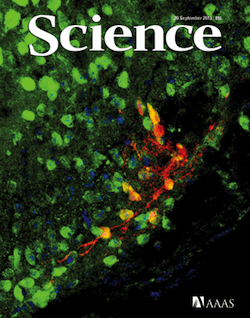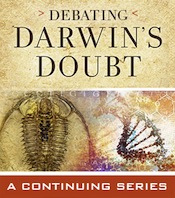 Evolution
Evolution
When Theory Trumps Observation: Responding to Charles Marshall’s Review of Darwin’s Doubt
 I’m pleased that the journal Science assigned my book Darwin’s Doubt for review to the distinguished UC Berkeley paleontologist Charles Marshall. His is the first critical review ("When Prior Belief Trumps Scholarship," September 20, 2013) to grapple with the book’s main arguments about the inability of standard evolutionary mechanisms to explain the origin of morphological novelty in the Cambrian period. Though Marshall does address the main problem discussed in the book, his review also demonstrates — if inadvertently — the severity of that problem, and that leading Cambrian paleontologists and evolutionary biologists (such as Dr. Marshall) are nowhere close to solving it.
I’m pleased that the journal Science assigned my book Darwin’s Doubt for review to the distinguished UC Berkeley paleontologist Charles Marshall. His is the first critical review ("When Prior Belief Trumps Scholarship," September 20, 2013) to grapple with the book’s main arguments about the inability of standard evolutionary mechanisms to explain the origin of morphological novelty in the Cambrian period. Though Marshall does address the main problem discussed in the book, his review also demonstrates — if inadvertently — the severity of that problem, and that leading Cambrian paleontologists and evolutionary biologists (such as Dr. Marshall) are nowhere close to solving it.
In coming days I will offer four responses to the four main critiques that Marshall presents of Darwin’s Doubt in his review. I begin here by addressing Marshall’s claim that developmental gene regulatory networks (dGRNs), which are necessary for the development of animals, could have been more labile or flexible in the past.1 Marshall made this claim to challenge my contention in Chapter 13 of Darwin’s Doubt that the observed inflexibility of these regulatory networks represents a major impediment to the evolutionary transformation of one animal body plan into another.2 Not so, he argues. As he asserted in his review, “today’s GRNs have been overlain with half a billion years of evolutionary innovation (which accounts for their resistance to modification), whereas GRNs at the time of the emergence of the phyla were not so encumbered."3
Yet, contrary to Marshall’s speculation about how dGRNs might have functioned in the past, all available observational evidence establishes that dGRNs do not tolerate random perturbations to their basic control logic. Indeed, mutagenesis experiments conducted on the genes present in dGRNs have repeatedly shown that even modest mutation-induced changes to these genes either produce no change in the developmental trajectory of animals (due to pre-programmed buffering or redundancy) or they produce catastrophic (most often, lethal) effects within developing animals. Disrupt the central control nodes, and the developing animal does not shift to a different, viable, stably heritable body plan. Rather, the system crashes, and the developing animal usually dies.4 As developmental biologist Eric Davidson has noted:
There is always an observable consequence if a dGRN subcircuit is interrupted. Since these consequences are always catastrophically bad, flexibility is minimal, and since the subcircuits are all interconnected, the whole network partakes of the quality that there is only one way for things to work. And indeed the embryos of each species develop in only one way.5
Thus, to claim, as Marshall does in his review of Darwin’s Doubt, that dGRNs might have been more elastic in the past contradicts what developmental biologists have learned over several decades investigating how these networks actually function from mutagenesis studies of many different biological "model systems," including Drosophila (fruit flies), Caenorhabditis (nematodes), Strongylocentrotus (sea urchins), Danio (zebrafish) and other animals.6 Moreover, as Marshall himself has noted elsewhere, there is a good reason for this inflexibility. As Marshall explains, “many of the characters that evolved during the origin of the phyla are no longer able to change. The reason for this is that selectable variation is absent: either the characters are invariant or mutants that carry this variation are sterile or lethal.”7
 Of course, Marshall thinks that these networks could have had a different, more flexible, character in the past. Yet, given what dGRNs do, namely, that they enable different cell types to organize themselves, and differentiate themselves from each other, in precise ways at precise times during the development of specific animal forms, it is hard to see how dGRNs could have functioned as regulatory networks and also exhibited the kind of flexibility that Marshall envisions. Developmental gene regulatory networks are control systems. A labile dGRN would generate (uncontrolled) variable outputs, precisely the opposite of what a functional control system does. It is telling that although many evolutionary theorists (like Marshall) have speculated about early labile dGRNs, no one has ever described such a network in any functional detail — and for good reason. No developing animal that biologists have observed exhibits the kind of labile developmental gene regulatory network that the evolution of new body plans requires. Indeed, Eric Davidson, when discussing hypothetical labile dGRNs, acknowledges that we are speculating "where no modern dGRN provides a model" since they "must have differed in fundamental respects from those now being unraveled in our laboratories."8
Of course, Marshall thinks that these networks could have had a different, more flexible, character in the past. Yet, given what dGRNs do, namely, that they enable different cell types to organize themselves, and differentiate themselves from each other, in precise ways at precise times during the development of specific animal forms, it is hard to see how dGRNs could have functioned as regulatory networks and also exhibited the kind of flexibility that Marshall envisions. Developmental gene regulatory networks are control systems. A labile dGRN would generate (uncontrolled) variable outputs, precisely the opposite of what a functional control system does. It is telling that although many evolutionary theorists (like Marshall) have speculated about early labile dGRNs, no one has ever described such a network in any functional detail — and for good reason. No developing animal that biologists have observed exhibits the kind of labile developmental gene regulatory network that the evolution of new body plans requires. Indeed, Eric Davidson, when discussing hypothetical labile dGRNs, acknowledges that we are speculating "where no modern dGRN provides a model" since they "must have differed in fundamental respects from those now being unraveled in our laboratories."8
By ignoring this evidence, Marshall and other defenders of evolutionary theory reverse the epistemological priority of the historical scientific method as pioneered by Charles Lyell, Charles Darwin and others.9 Rather than treating our present experimentally based knowledge as the key to evaluating the plausibility of theories about the past, Marshall uses an evolutionary assumption about what must have happened in the past (transmutation) to justify disregarding experimental observations of what does, and does not, occur in biological systems. The requirements of evolutionary doctrine thus trump our observations about how nature and living organisms actually behave. What we know best from observation takes a back seat to prior beliefs about how life must have arisen.
In the next installment in this series, I’ll address Marshall’s claim that building Cambrian animals would not have required large amounts of new genetic information –� as I argue in Darwin’s Doubt — but instead could have been produced by the “rewiring” of preexisting developmental gene regulatory networks.
NOTES:
(1) Charles R. Marshall, "When Prior Belief Trumps Scholarship," Science 341 (September 20, 2013): 1344.
(2) Stephen C. Meyer, Darwin’s Doubt: The Explosive Origin of Animal Life and the Case for Intelligent Design. HarperOne, 2013, 264-270.
(3) Charles R. Marshall, "When Prior Belief Trumps Scholarship," Science 341 (September 20, 2013): 1344.
(4) See Eric H. Davidson, "Evolutionary Bioscience as Regulatory Systems Biology," Developmental Biology, 357 (September 1, 2011): 35-40. See also the discussion in Darwin’s Doubt, pp. 264-70.
(5) See Eric H. Davidson, "Evolutionary Bioscience as Regulatory Systems Biology," Developmental Biology, 357 (September 1, 2011): 40.
(6) See, for example, the discussion of the model system Strongylocentrotus purpuratus in: P. Oliveri, Q. Tu, and E. H. Davidson, “Global Regulatory Logic for Specification of an Embryonic Cell Lineage,” Proceedings of the National Academy of Sciences USA, 105 (2008): 5955-62. For a diagrammed schematic of the dGRN network of Strongylocentrotus purpuratus see Figure 1D in this article.
(7) See N.H. Shubin and C.R. Marshall, “Fossils, Genes, and the Origin of Novelty,” Paleobiology 26, no. 4, Supplement (2000): 335. (Emphasis added).
(8) Eric H. Davidson, "Evolutionary Bioscience as Regulatory Systems Biology," Developmental Biology, 357 (September 1, 2011): 40.
(9) See Charles Lyell, Principles of Geology: Being an Attempt to Explain the Former Changes of the Earth’s Surface, by Reference to Causes Now in Operation. 3 vols. London: Murray, 1830-33, pp. 75-91.
